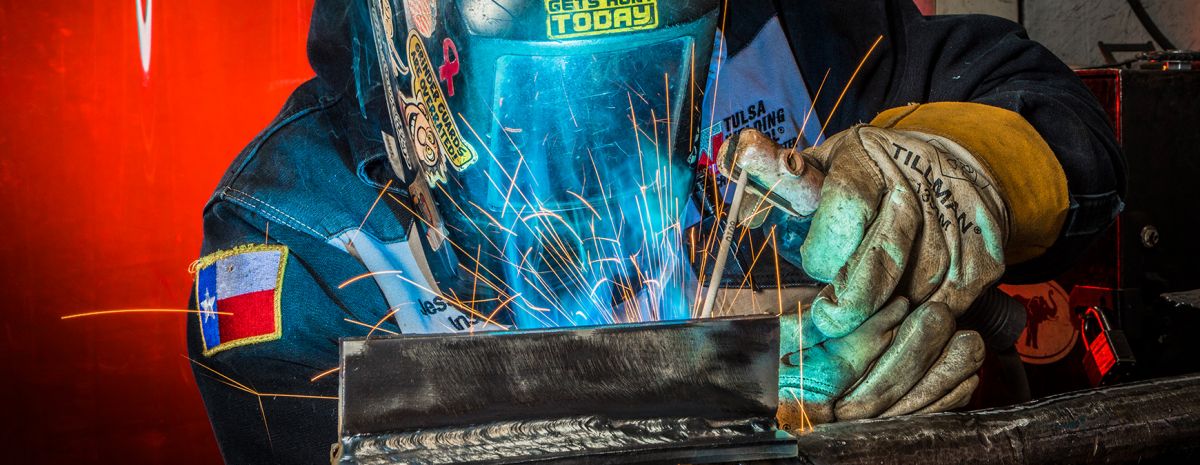
Welding is an equally rewarding and challenging trade that requires constant development and improvement.
The welders who achieve long-term success in the skilled trades are always eager to learn something new. Once you’ve mastered the various welding techniques, you can start focusing on perfecting a weld.
A common cause of low-quality welds is a process known as oxidation.
Learning how to avoid this reaction will result in professional-grade, sturdy, and long-lasting welds in various applications.
What is oxidation in welding?
Oxidation is a chemical reaction that occurs when a metal comes in contact with oxygen.
Get Started on the Path to a New Career
Fill out our form to learn how we can help you change your life.
Scientifically speaking, this process sees a compound lose an electron after interacting with another element. While generally seen as a negative factor in welding, oxidation actually has a positive application when used properly.
An oxide can act as a protective layer separating a fresh weld from the environment while it solidifies. On the other hand, oxidation can hurt the integrity and strength of a weld by causing corrosion.
Welders have to find a way to control the amount of oxygen near a weld in order to maintain its quality.
What causes oxidation?
Oxidation results from the interaction between metals and oxygen in all its forms. Keep in mind that oxygen is present in both air and water.
This means you have to be mindful of humidity, steam, and other things containing water vapor when perfecting a weld.
Air Oxidation
There are numerous welding techniques, and all take place in the presence of oxygen in the surrounding air.
It’s an inescapable factor that requires some due diligence to prevent oxidation damage. As metal is heated in the welding process, a layer of oxide develops. This oxide covering protects the weld until it reaches a certain temperature, known as the maximum surface temperature.
Beyond this point, the protective layer will crack and the negative effects of oxidation will ensue.
Water Oxidation
It’s easy to forget about the oxygen present in water, such as vapor or steam, since it’s not as prevalent as oxygen in the air.
This oxidation poses a higher risk to the strength of welds than its gaseous counterpart. Oxidation resulting from water vapors occurs quicker, which requires faster reactions from welders.
These oxide layers are less protective due to their porous nature. Anytime the air is rich with water content, welders should keep an eye out for the potential of oxidation.
What does oxidation do to metals?
Oxidation is detrimental to the quality and longevity of welds when it’s not properly controlled.
Oxygen has the power to corrode metals over time, resulting in a weaker, less attractive, and more porous weld. Rust is a common symptom of corrosion caused by oxidation that most welders have seen in their daily lives.
The majority of metals welders work with on a daily basis are subject to oxidation. Some metals, such as steel, show the effects of corrosion and oxidation much more obviously than other materials.
How do you stop oxidation in welding?
Shield the metal.
One of the most effective methods for preventing the harmful effects of oxidation is the use of shielding gases.
Also known as inert or semi-inert gases, they create a protective barrier between the weld and harmful atmospheric gases. These gases can influence the heat of the arc and how the weld looks.
The main function of shielding gases is to keep the weld pool from oxidizing.
Use purging gas.
Gas purging is another effective weapon in the welder’s arsenal to fight oxidation.
Purging gases remove oxygen, nitrogen, and other problematic gases from the weld during and shortly after the welding process.
This use of purging gas is essential when welders work with reactive metals such as magnesium alloys, titanium, stainless steel, or tantalum since these metals are more susceptible to the harms of oxidation.
Clear oxygen from the shielding gas.
Shielding gases are critical for protecting a weld from oxidation. However, oxygen can sometimes sneak into the protective gas and damage a weld as the shielding gas is applied. In fact, it’s one of the most common culprits of oxidation.
Before applying a shielding gas, welders should take the time to remove as much oxygen as possible from the supply.
Start your career as a Welding Specialist.
The aim of RSI’s Welding Specialist program is to equip students with the welding skills necessary for entry-level positions in thin alloy, structural, and pipe and pipeline welding. These types of welding have applications in several key industries: construction, transportation, manufacturing, petroleum and many more.
Eager to see what the welding profession can offer? Take a look at these 3 welding careers. You might just find your dream job.
This blog has been labeled as archived as it may no longer contain the most up-to-date data. For a list of all current blog posts, please visit our blog homepage at https://www.rsi.edu/blog/

